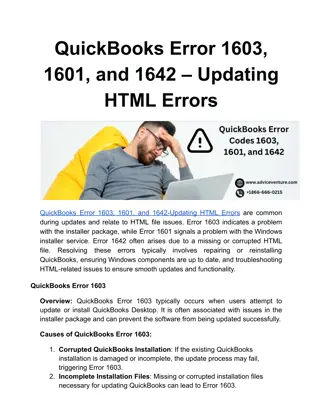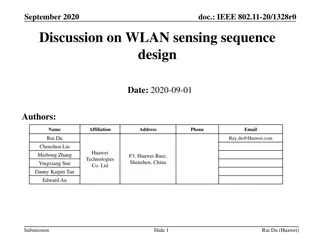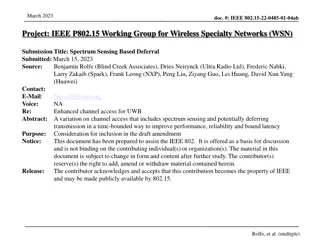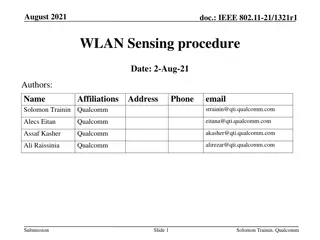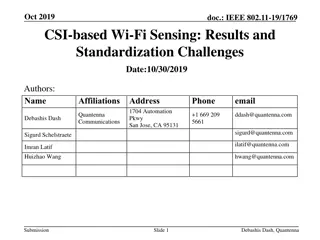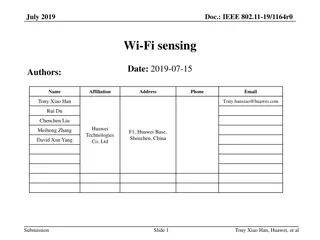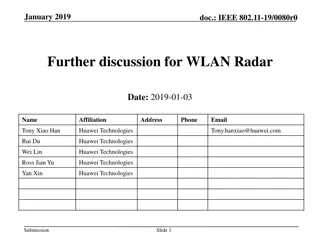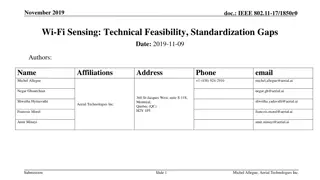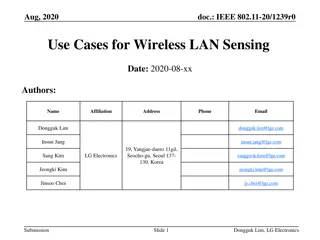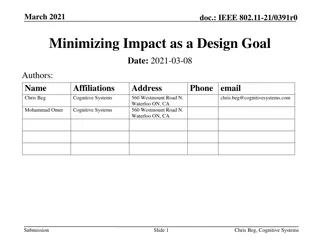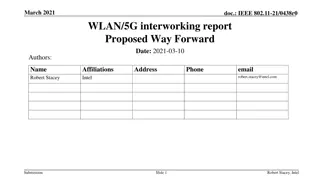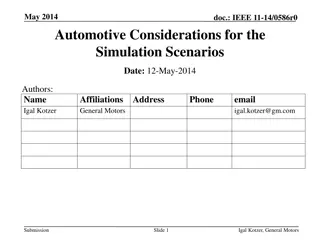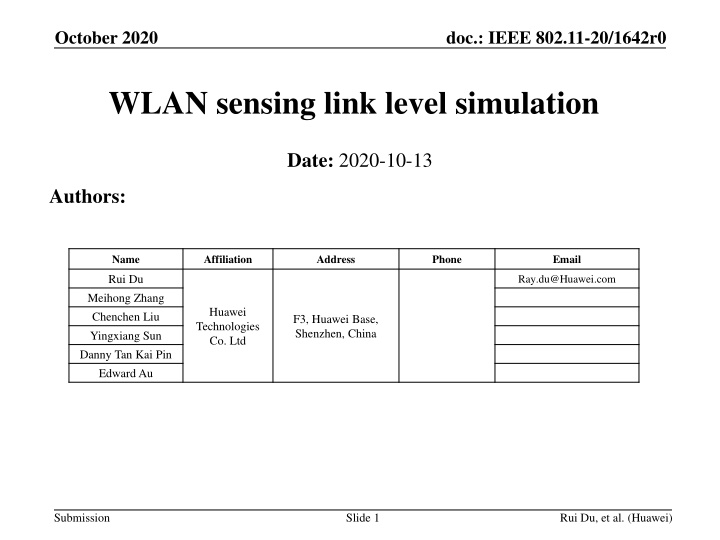
IEEE 802.11-20 WLAN Sensing Link Level Simulation Overview
Explore the IEEE 802.11-20 WLAN Sensing Link Level Simulation presentation by Huawei, focusing on calibration, environment modeling, and algorithms. Learn about waveform generation, transmitter modules, and performance evaluation in indoor and outdoor settings.
Download Presentation

Please find below an Image/Link to download the presentation.
The content on the website is provided AS IS for your information and personal use only. It may not be sold, licensed, or shared on other websites without obtaining consent from the author. If you encounter any issues during the download, it is possible that the publisher has removed the file from their server.
You are allowed to download the files provided on this website for personal or commercial use, subject to the condition that they are used lawfully. All files are the property of their respective owners.
The content on the website is provided AS IS for your information and personal use only. It may not be sold, licensed, or shared on other websites without obtaining consent from the author.
E N D
Presentation Transcript
October 2020 doc.: IEEE 802.11-20/1642r0 WLAN sensing link level simulation Date: 2020-10-13 Authors: Name Affiliation Address Phone Email Rui Du Ray.du@Huawei.com Meihong Zhang Chenchen Liu Yingxiang Sun Danny Tan Kai Pin Edward Au Huawei Technologies Co. Ltd F3, Huawei Base, Shenzhen, China Submission Slide 1 Rui Du, et al. (Huawei)
October 2020 doc.: IEEE 802.11-20/1642r0 Outline Abstract WLAN sensing link level simulation Key modules may need to be calibrated Common environment model/channel model Common basic algorithms Summary Submission Slide 2 Rui Du, et al. (Huawei)
October 2020 doc.: IEEE 802.11-20/1642r0 Abstract TG bf has been established recently, and simulation is potentially needed to compare the performance from different contributions. In this presentation: WLAN sensing link level simulation is presented and discussed. two key modules may need calibration are further discussed. Submission Slide 3 Rui Du, et al. (Huawei)
October 2020 doc.: IEEE 802.11-20/1642r0 1 link level simulation Transmitter Waveform generation Environment/channel model Channel Target, interference and noise Number of targets Parameters (RCS, delay, velocity, ) Array geometry Element radiation pattern (gain) ERIP Location Indoor Type (new sequence, new waveform, WLAN PPDU, ) Parameters (PRI, BW, fs, duration ) Number of clutter Parameters (reflectivity, delay, AoD, AoA, ) Outdoor Noise Receiver Signal processing and performance evaluation Performance evaluation Parameter estimation Array geometry Element radiation pattern (gain) Array and element errors Location Sampling parameters (fs, duration ) Range estimation Velocity estimation Angle estimation Range accuracy Velocity accuracy Angle accuracy Submission Slide 4 Rui Du, et al. (Huawei)
October 2020 doc.: IEEE 802.11-20/1642r0 1.1 Waveform generation Different waveforms are generated in this module which includes: New sequences New waveforms WLAN PPDUs with modification Normal WLAN PPDU Submission Slide 5 Rui Du, et al. (Huawei)
October 2020 doc.: IEEE 802.11-20/1642r0 1.2 Transmitter The signal is transmitted in this module with following parameters: Antenna pattern/array geometry Element radiation pattern (gain) EIRP Transmitter s location Submission Slide 6 Rui Du, et al. (Huawei)
October 2020 doc.: IEEE 802.11-20/1642r0 1.3 Environment/channel model The parameters of targets and multipath are added in this module which includes: Target s parameters - Numbers, RCS, Delay, Velocity, AOD, AOA, Multipath parameters - Inter cluster: Numbers, Delay, Power, AOD, AOA, - Intra cluster: Average number of rays, Ray arrival rate, Ray power decay time (parameters for Poisson process) Noise Submission Slide 7 Rui Du, et al. (Huawei)
October 2020 doc.: IEEE 802.11-20/1642r0 1.4 Receiver The signal is received in this module with following parameters: Antenna pattern/array geometry Element radiation pattern (gain) Receiver s location Submission Slide 8 Rui Du, et al. (Huawei)
October 2020 doc.: IEEE 802.11-20/1642r0 1.5 Signal Processing The received signal is processed with different algorithms to estimate target s parameters and analyzes its relevant performance metrics: Range estimation (range accuracy) Velocity estimation (velocity accuracy) Angle estimation (angle accuracy) Submission Slide 9 Rui Du, et al. (Huawei)
October 2020 doc.: IEEE 802.11-20/1642r0 2.1 Key modules may need to be calibrated -common environment model/channel model A common environment model/channel model is needed for the comparison of performance from different contributions. The environment should include[1, 2]: a few typical scenarios for WLAN sensing - Specific configurations (size of environment, objects properties in the environment, frequency, bandwidth, antenna configuration, ) Target(s) to be sensed - Specific configurations (location, trajectory, ) Previously discussions indicate that a few types of channel models(e.g. radar channel model, WLAN sensing channel model[1,2]) could be adopted for WLAN sensing. But, no matter which kind of channel model will be adopted by the group finally, it should be calibrated. Submission Slide 10 Rui Du, et al. (Huawei)
October 2020 doc.: IEEE 802.11-20/1642r0 2.2 Key module may need to be calibrated - common basic sensing algorithms For WLAN sensing, many algorithms are needed for target parameter estimation. There are two options for these algorithms that may be adopted in WLAN sensing. Option 1: Some basic algorithms could be adopted commonly in the group to analyze the sensing performance (only affected by the standard modification). Option 2: Put no restrictions on the algorithms and just compare the sensing performance (affected both by the standard modification and algorithms). Submission Slide 11 Rui Du, et al. (Huawei)
October 2020 doc.: IEEE 802.11-20/1642r0 Summary A potential link level simulation for WLAN sensing and its initial analysis is presented in this contribution. Two key modules (common environment model/channel model and common basic sensing algorithms) may need to be calibrated between different WLAN sensing contributions for the comparison of standard modification are discussed. Submission Slide 12 Rui Du, et al. (Huawei)
October 2020 doc.: IEEE 802.11-20/1642r0 References [1] 11-20-0906-00-SENS-discussion-of-channel-model-for-wlan- sensing.pptx [2] 11-20-1334-00-SENS-a-brief-description-of-the-channel- realization-generation-process.pptx Submission Slide 13 Rui Du, et al. (Huawei)
October 2020 doc.: IEEE 802.11-20/1642r0 SP 1 Do you support that the link level simulation proposed in slide 4 should be used in WLAN sensing simulation? Yes: No: Abstain: Submission Slide 14 Rui Du, et al. (Huawei)
October 2020 doc.: IEEE 802.11-20/1642r0 SP 2 Do you support that the modules (environment/channel model and basic sensing algorithms) should be calibrated between different WLAN sensing contributions for the further performance comparison? Yes: No: Abstain: Submission Slide 15 Rui Du, et al. (Huawei)



